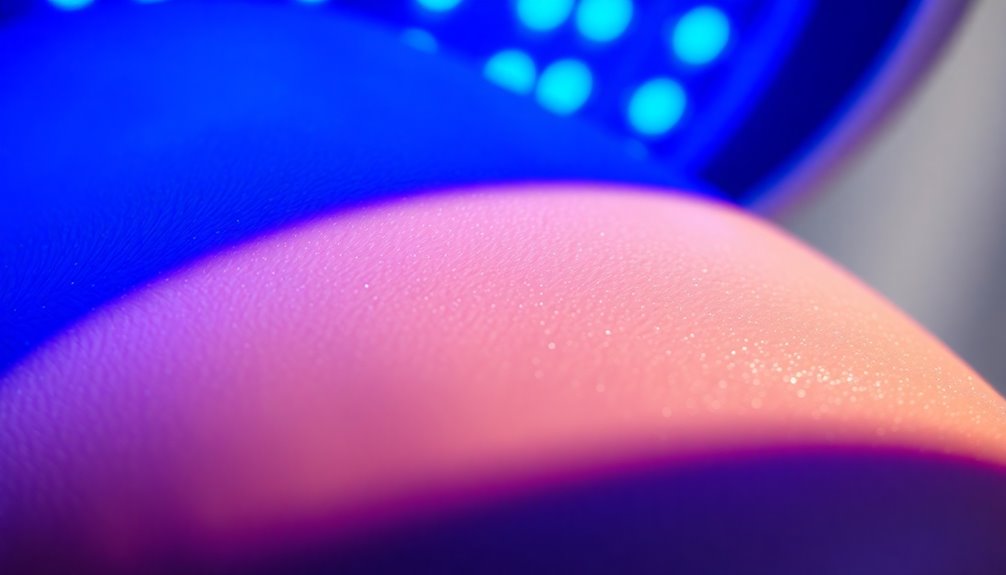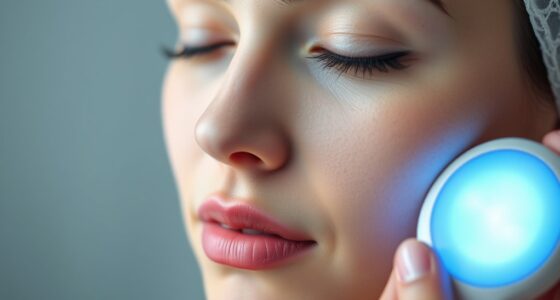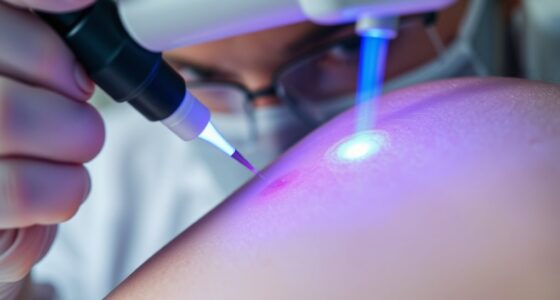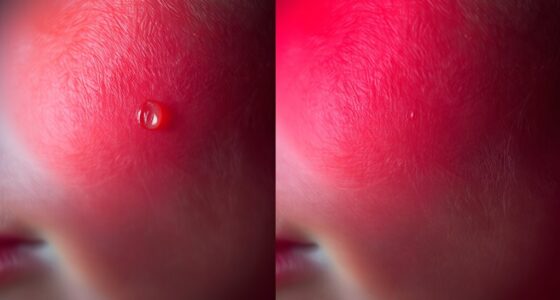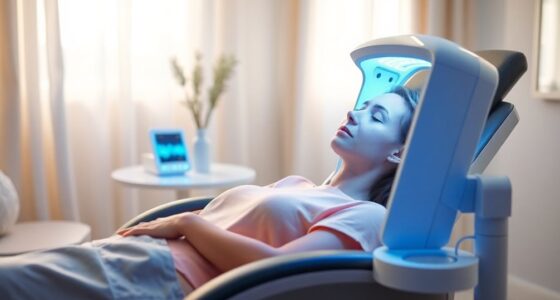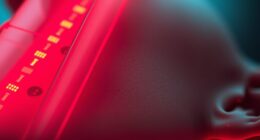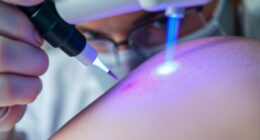Blue light therapy targets acne-causing bacteria by using wavelengths between 405-420 nm. When the blue light penetrates your skin, it's absorbed by bacteria like Propionibacterium acnes, which contain porphyrins. This absorption triggers a reaction that produces harmful free radicals that damage and kill the bacteria, all while leaving healthy skin cells unharmed. The treatment can significantly reduce acne lesions and inflammation, making it a great option if you're unresponsive to conventional therapies. There's much more to this therapy, including its effectiveness and potential combinations with other treatments.
Key Takeaways
- Blue light therapy targets acne-causing bacteria using wavelengths between 405-420 nm, specifically peaking at 415 nm for maximum effectiveness.
- The therapy triggers a photodynamic reaction in Propionibacterium acnes, generating reactive oxygen species that damage and kill the bacteria.
- Porphyrins produced by Cutibacterium acnes absorb blue light, enhancing the bacteria's susceptibility and promoting the therapy's effectiveness.
- The treatment selectively targets sebaceous glands while preserving healthy skin cells, making it non-invasive and painless compared to traditional antibiotics.
- Blue light therapy offers a viable option for acne treatment, particularly for patients resistant to conventional therapies and for reducing antibiotic reliance.
Mechanism of Action
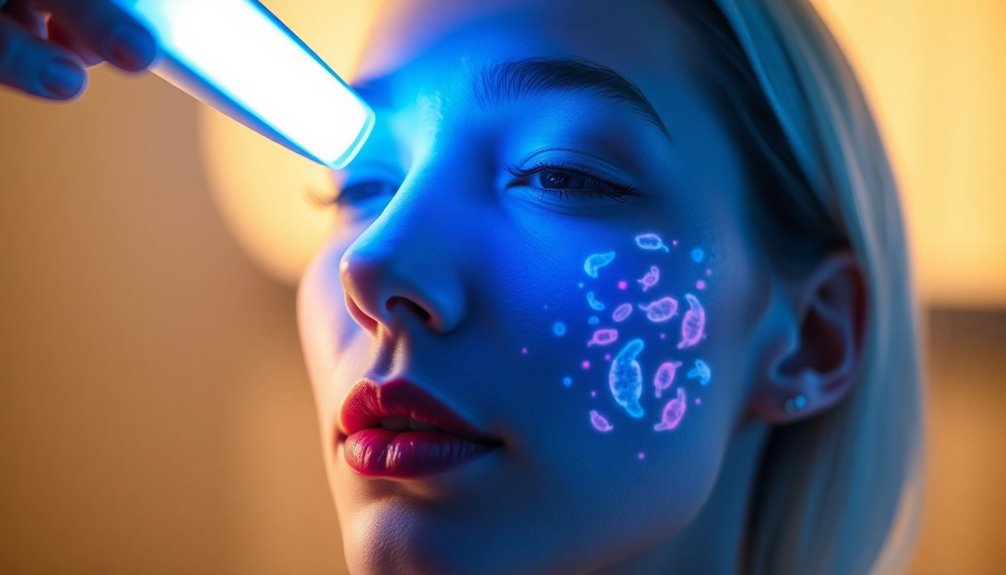
When you undergo blue light therapy for acne, the treatment works by using specific wavelengths of light that target the bacteria responsible for breakouts.
The blue light, with a wavelength between 405 to 420 nanometers, penetrates the epidermis and is absorbed by the acne-causing bacteria, primarily Propionibacterium acnes. This absorption triggers a photodynamic reaction that destroys the bacteria through free radical damage.
As a result, you'll notice a reduction in both inflammatory and non-inflammatory lesions. The therapy selectively damages these bacteria without harming your surrounding skin, promoting improved overall skin health. Furthermore, blue light therapy is increasingly recognized as a viable treatment option for patients unresponsive to medical therapy, making it a valuable choice for managing acne.
With minimal side effects, blue light therapy offers a non-invasive solution for preventing future breakouts and enhancing your skin's appearance.
Role of Porphyrins
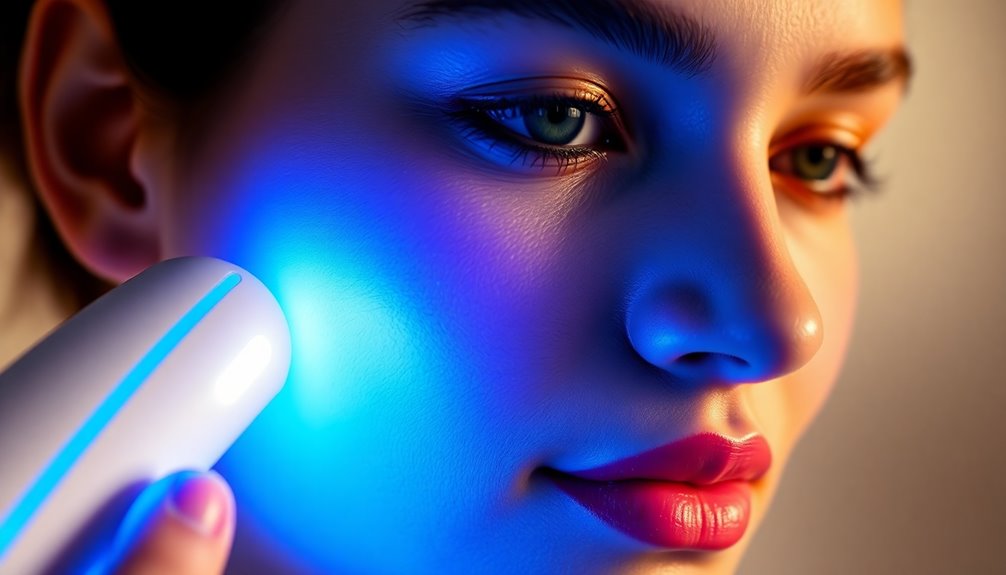
Porphyrins play a crucial role in the effectiveness of blue light therapy for acne. _Cutibacterium acnes_, the bacteria linked to acne, produces large amounts of porphyrins, which absorb blue light in the 405-420 nm range.
When exposed to this light, these porphyrins generate reactive oxygen species that damage and destroy the bacteria. Notably, acne-associated strains produce significantly higher levels of porphyrins compared to health-associated strains, making them more susceptible to treatment. Additionally, using delta-aminolevulinic acid (ALA) can boost porphyrin synthesis, enhancing the therapy's effectiveness. This non-invasive photodynamic therapy interaction is key to reducing acne lesions and inflammation, addressing the root cause of acne vulgaris and improving overall skin health.
Wavelength Specificity
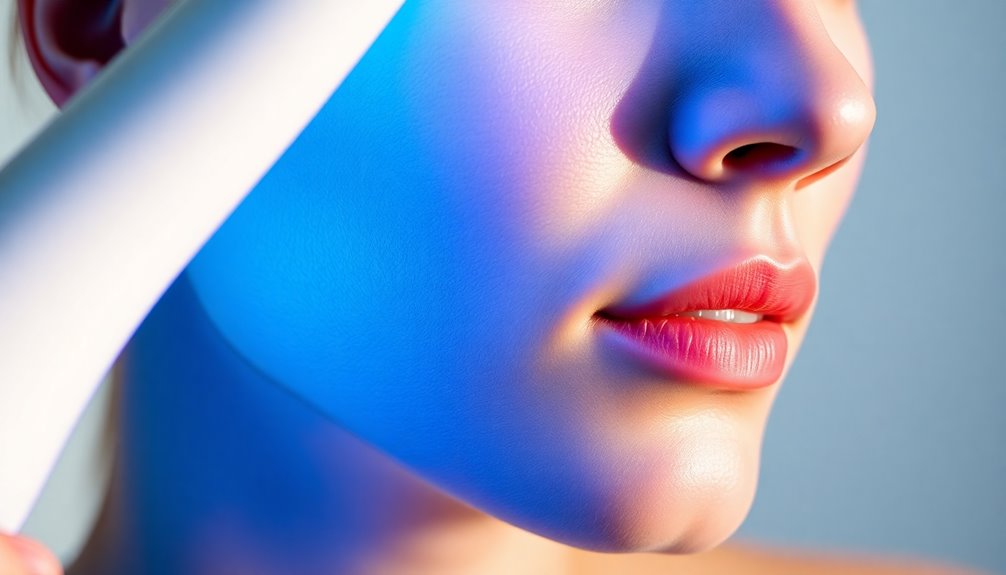
Blue light therapy's effectiveness hinges on its specific wavelength range, primarily between 405 and 420 nm, which is optimal for targeting acne-causing bacteria.
This range allows blue light to penetrate about 0.3 mm into your skin, specifically reaching the superficial layers where P. acnes bacteria reside. The peak absorption occurs at 415 nm, making it the most efficient for photodestruction of porphyrins within these bacteria.
Unlike other wavelengths that penetrate deeper, blue light selectively targets the bacteria without harming surrounding healthy skin cells. This selective targeting is crucial because the microbial abundance in these superficial layers can influence the severity of acne.
Because of its UV-free nature, this therapy is non-phototoxic, making it a safe option for acne treatment. Plus, it can effectively overcome bacterial resistance to conventional antibiotics.
Photokilling Process
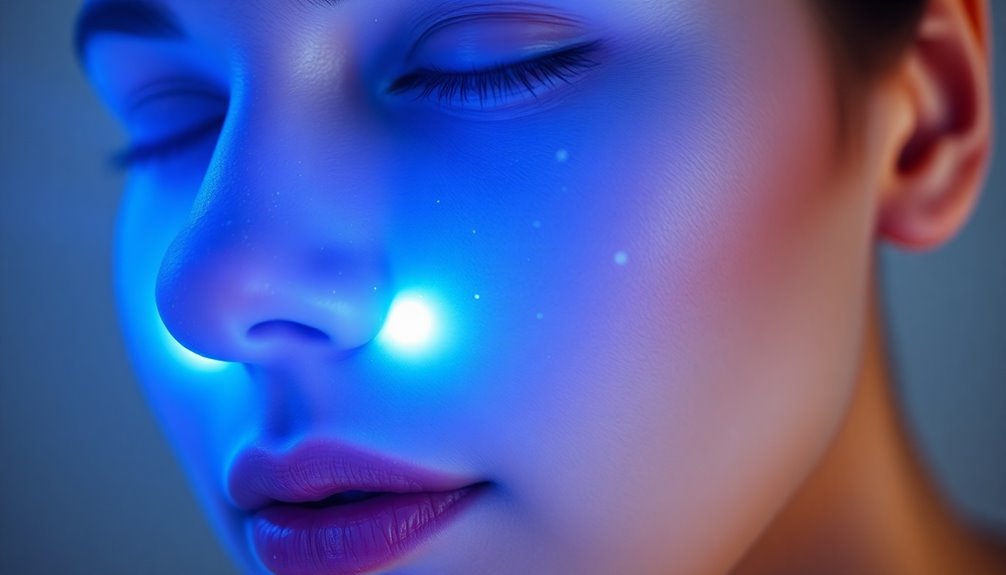
The photokilling process is central to how blue light therapy effectively treats acne. Acne-causing bacteria, specifically P. acnes, produce porphyrins that absorb blue light at wavelengths of 405-420 nm. When you expose these bacteria to blue light, the porphyrins generate free radicals, causing significant cellular damage and ultimately killing the bacteria. While the efficiency of this process is naturally low, it improves with multiple light sessions or by using a photosensitizing agent like aminolevulinic acid (ALA). Research has shown that resistance to common antibiotics exceeds 40% in P. acnes strains, highlighting the need for alternative treatments. Blue light specifically targets the sebaceous glands, where P. acnes reside, and isn't harmful to your skin cells. This makes it a safe and effective acne treatment, especially when combined with other therapies to enhance results.
Clinical Applications
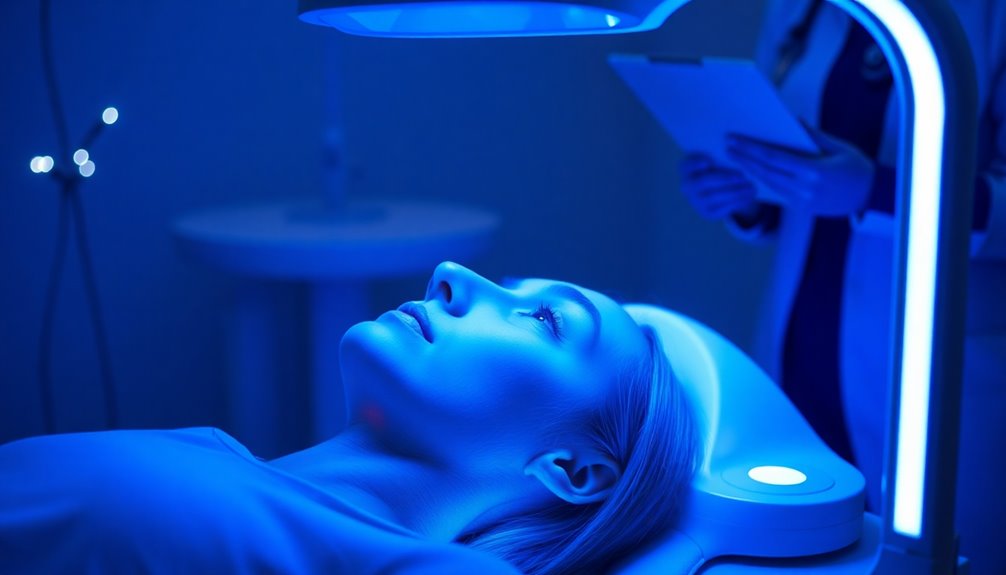
Clinical applications of blue light therapy for acne are gaining traction due to its effectiveness and accessibility. You can receive this treatment in a dermatologist's office, typically spaced every two weeks, with two sessions per week over a month. If you prefer at-home options, self-administered devices are available but should be used under a dermatologist's guidance. Studies show significant improvement in acne severity, with some patients experiencing a 64% reduction in lesions. While results may take weeks to show and vary individually, many users report over 90% satisfaction with their skin's appearance. However, many studies have shown a high risk of bias, which may affect the overall conclusions when selecting devices, ensure they're FDA-cleared and consider those with adjustable settings for a tailored approach to your skin type.
Safety and Side Effects
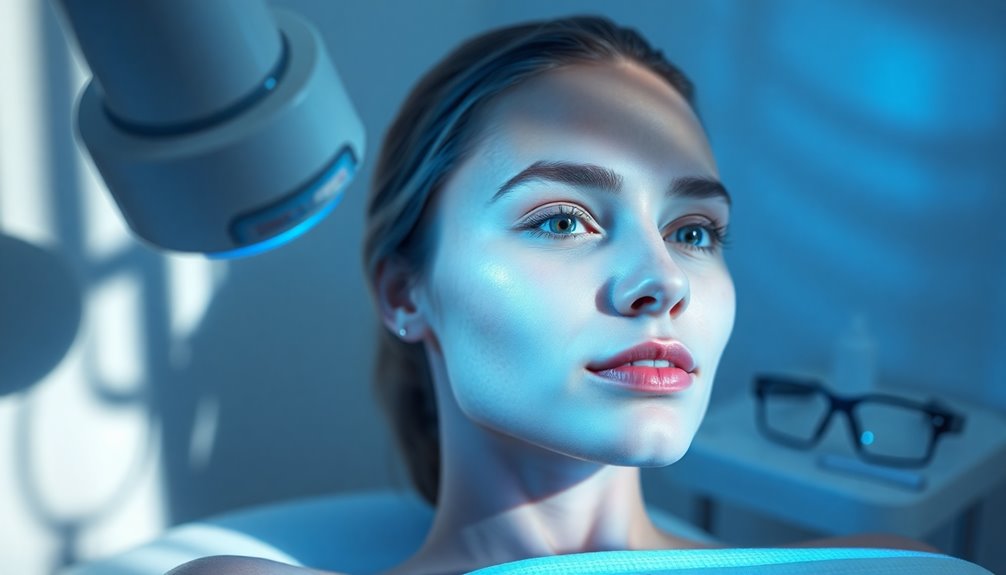
While blue light therapy offers a promising option for acne treatment, understanding its safety and potential side effects is crucial. This non-invasive therapy doesn't use UV rays, minimizing risks of skin damage. It's FDA-approved for moderate acne, but research on long-term effects is limited. You might experience mild side effects like temporary redness, swelling, or peeling in the treated area. Additionally, blue light therapy has been proven to be a safe alternative for individuals preferring natural treatments. There's also a risk of infection if you don't care for the area properly. If you have conditions like porphyria or lupus, or are pregnant, you should avoid this treatment. Afterward, monitor your skin for signs of infection and keep up with proper care to enhance the treatment's effectiveness.
Advantages of Blue Light Therapy
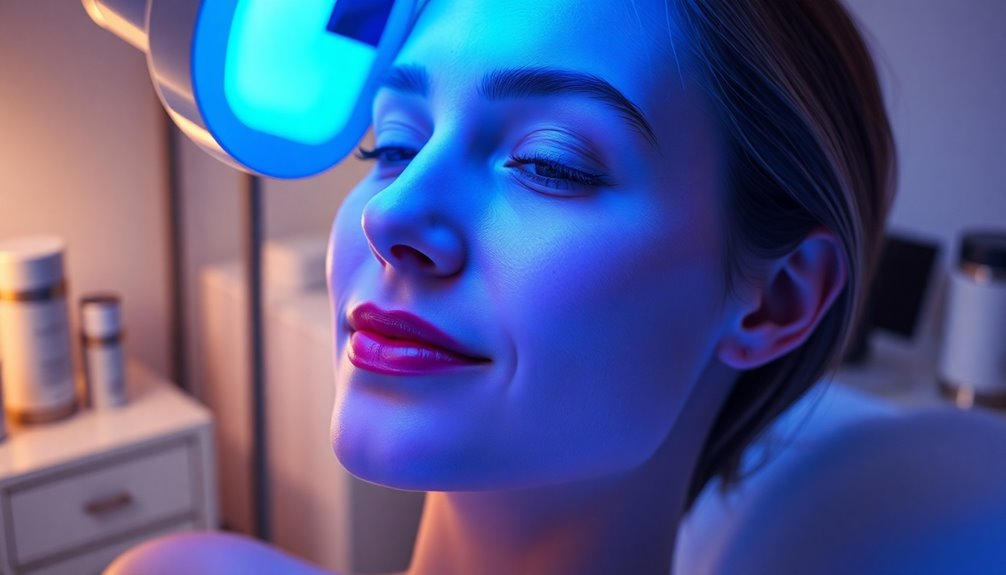
Blue light therapy offers numerous advantages for those struggling with acne, making it an appealing option for treatment. One of the primary blue light therapy benefits for acne is its ability to target the acne-causing bacteria, reducing inflammation and preventing future breakouts. Additionally, this non-invasive treatment is often well-tolerated, with minimal side effects, making it a safe choice for various skin types. As individuals seek effective alternatives to traditional acne treatments, blue light therapy continues to emerge as a viable solution.
Studies show it can reduce acne lesions by 54% to 65%, effectively targeting the P. acnes bacteria responsible for breakouts. This therapy also boasts anti-inflammatory effects, easing redness and swelling.
As a non-invasive treatment, it avoids antibiotics, making it a safer choice for many. You can use it at home with available devices or have it administered in a dermatologist's office, ensuring convenience. Additionally, blue light therapy enhances collagen production, improving skin elasticity and reducing fine lines.
With over 90% of participants reporting better skin clarity and texture, it's a gentle, effective solution for all skin types. Moreover, studies indicate that blue light therapy can achieve a 77% improvement in acne lesions after five weeks of treatment.
Limitations and Considerations
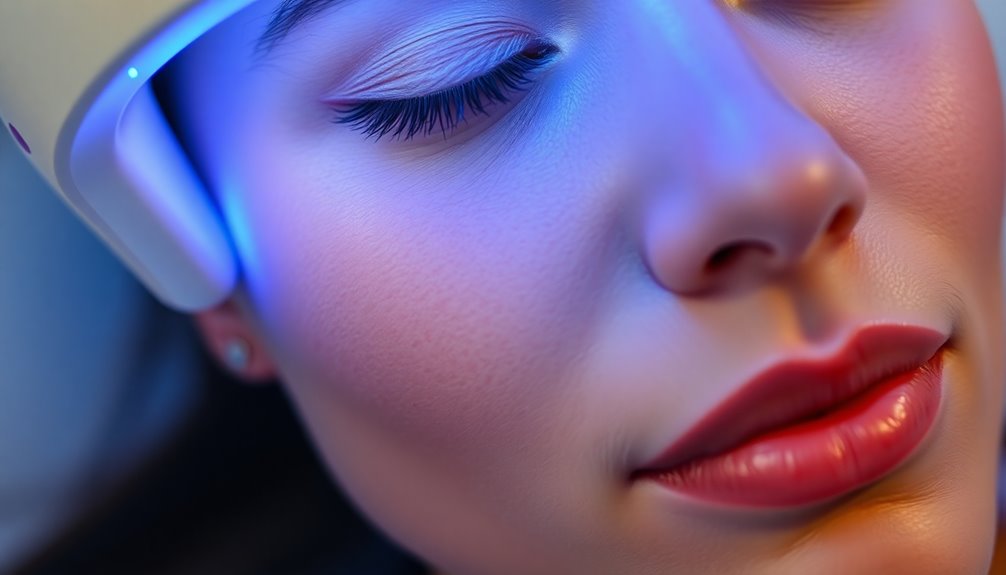
When considering blue light therapy as an acne treatment, it's essential to recognize its limitations and factors that could affect your results.
This therapy is generally effective for mild to moderate acne but may not work for severe cases or nodulocystic acne. Individual responses can vary, meaning you mightn't see significant improvements. Additionally, blue light therapy is FDA-approved for treating moderate acne vulgaris, which underscores its clinical validity.
Minor side effects like swelling and dryness can occur, and using photosensitizing agents may complicate treatment. Regular sessions are necessary, and a dermatologist's supervision is recommended for safety.
Cost and accessibility might also be concerns, as blue light therapy can be pricier than other treatments.
Ultimately, it may work best when combined with other therapies for optimal results.
Comparison With Other Treatments
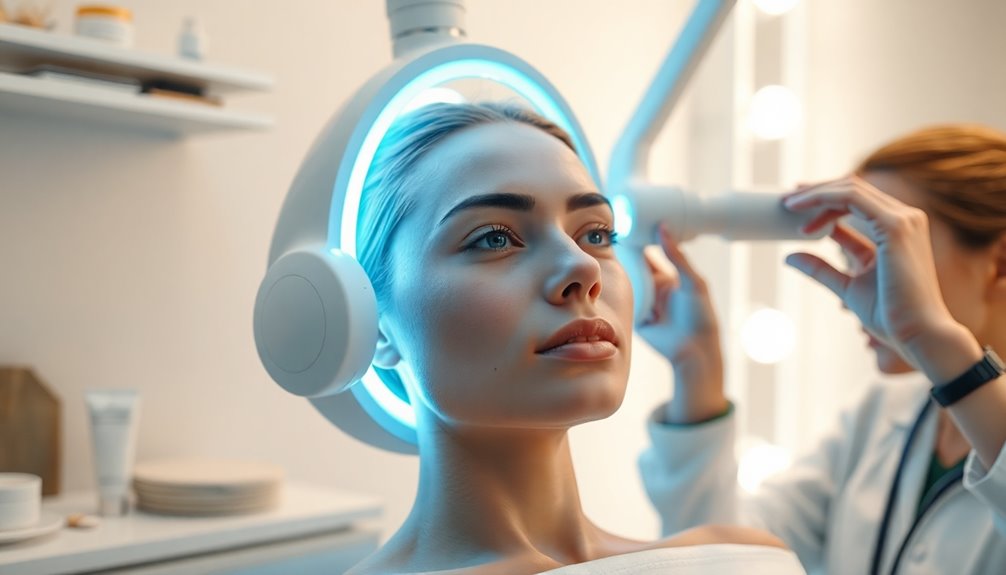
As you explore acne treatment options, comparing blue light therapy with other methods can help you make an informed decision.
Blue light therapy effectively targets acne-causing bacteria with minimal side effects, unlike oral antibiotics that may lead to resistance and discomfort. Additionally, blue light therapy utilizes specific wavelengths of light to penetrate the skin and reach sebaceous glands where bacteria reside.
While topical treatments like benzoyl peroxide can cause dryness and irritation, blue light therapy is non-invasive and painless.
Red light therapy promotes healing but lacks the antibacterial properties that blue light offers.
If you have moderate acne vulgaris, blue light therapy could be a safer alternative.
Dermatologists often recommend it, especially when other methods fall short.
You might consider combining treatments for enhanced results, but blue light therapy stands out for its effectiveness and patient-friendly experience.
Future Directions in Research
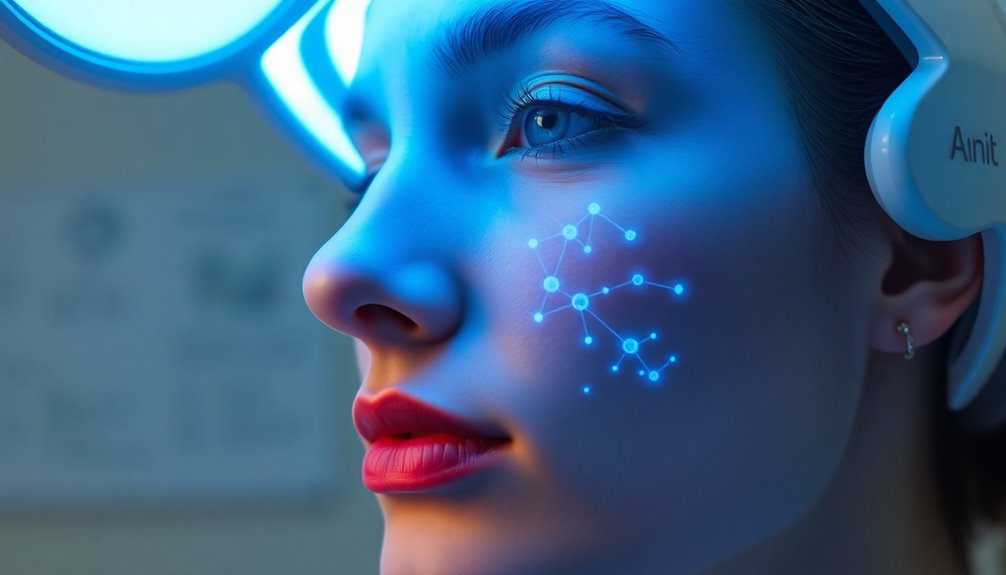
While blue light therapy has shown promise in treating acne, researchers are now focusing on future directions to enhance its effectiveness. They're exploring combination therapies, integrating blue light with other treatments like diode lasers or red light to boost results. Optimizing the dose and duration is another priority, ensuring maximum impact on acne-causing bacteria. Personalized treatment plans tailored to individual skin types could improve outcomes as well. On a mechanistic level, scientists are working to clarify how blue light targets P. acnes and reduces inflammation.
Technological advancements aim to refine device functionality and enhance patient accessibility. Lastly, establishing standardized treatment protocols and monitoring methods will help identify ideal candidates for blue light therapy, ensuring better results overall. Given that antibiotic resistance has been observed in over 94% of acne cases, incorporating blue light therapy may provide a valuable alternative to traditional methods.
Frequently Asked Questions
How Long Does a Typical Blue Light Therapy Session Last?
A typical blue light therapy session lasts between 10 to 30 minutes, depending on whether you're at home or in an office.
In-office treatments usually take 15-30 minutes and are more intense, while at-home sessions range from 10-20 minutes.
You'll likely need to schedule these sessions 2-3 times a week for about 4-6 weeks to see the best results.
Consistency is key, so stick to your routine for optimal outcomes.
Can Blue Light Therapy Be Used on All Skin Types?
Blue light therapy is generally safe for most skin types, so you can likely benefit from it.
However, if you have a photosensitivity disorder, it's best to avoid it.
While it can be effective for sensitive skin, you might experience temporary redness or dryness.
Dermatologists can help determine if it's suitable for your skin condition, especially if you're dealing with mild to moderate acne.
Always consult a professional for personalized advice.
Is Blue Light Therapy Suitable for Teenagers With Acne?
Yes, blue light therapy is suitable for teenagers with acne.
It reduces bacteria, calms inflammation, and promotes healing—all essential for clearer skin. Many teens report noticeable results, experiencing smaller pimples and improved texture.
The treatment is non-invasive, gentle on sensitive skin, and generally has minimal side effects. You can even combine it with other therapies for enhanced results.
How Soon Can I Expect to See Results From Treatment?
You can expect to see results from blue light therapy in about 4-6 weeks, depending on your skin's condition and severity of acne.
Many people notice initial improvements within the first few sessions, with consistent treatments 2-3 times a week.
However, individual experiences may vary, so it's essential to stay committed and possibly incorporate maintenance sessions to keep your skin clear and healthy over time.
Are There Any Home Devices for Blue Light Therapy?
Yes, there are several home devices for blue light therapy that you can use conveniently.
Options include full-face masks, handheld light pens, and spot treatment tools.
These devices are generally affordable and easy to use, featuring pre-programmed sessions so you can treat your skin without hassle.
They allow you to manage acne effectively from the comfort of your home, making skin care more accessible and tailored to your needs.
Conclusion
In conclusion, blue light therapy offers a promising approach to treating acne by targeting the bacteria responsible for breakouts. As the saying goes, "an ounce of prevention is worth a pound of cure." By incorporating this treatment into your skincare routine, you can effectively reduce the presence of acne-causing bacteria while enjoying the advantages it brings. Just remember to weigh its limitations and consult with a professional to find the best solution for your skin.
